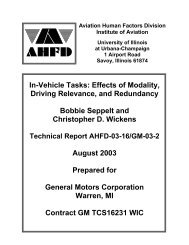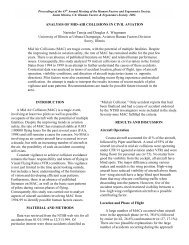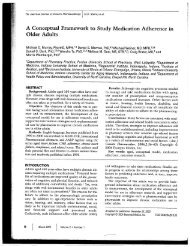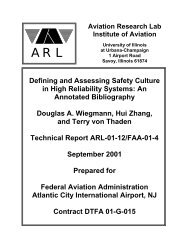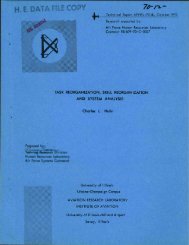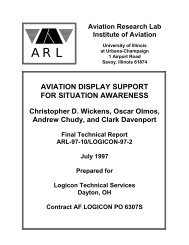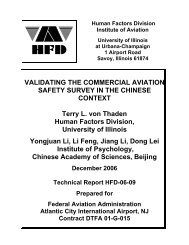Usability Questionnaire Results - Institute of Aviation - University of ...
Usability Questionnaire Results - Institute of Aviation - University of ...
Usability Questionnaire Results - Institute of Aviation - University of ...
You also want an ePaper? Increase the reach of your titles
YUMPU automatically turns print PDFs into web optimized ePapers that Google loves.
complexity <strong>of</strong> the power system and its real time dynamics while dealing with high levels <strong>of</strong>workload.Moray (1997) sums up many <strong>of</strong> the human factors challenges that occur in processcontrol. Some <strong>of</strong> these include designing control rooms to support safe and economic operation,shifting from physical skills to cognitive skills due to increased use <strong>of</strong> automation (supportingdecision making), the design and evaluation <strong>of</strong> advanced interfaces, and the identification <strong>of</strong> agood balance between prescribed activities and creative intervention.One important role <strong>of</strong> operators in a process control system is to monitor the state <strong>of</strong> thesystem. Operators have a particular interest in detecting faults within a system and being able todiagnose the underlying cause <strong>of</strong> the failures. These two important tasks will be examined in thecontext <strong>of</strong> process control.2.1.1 DetectionThe detection <strong>of</strong> abnormal and fault conditions in a process control setting such asnuclear power or power systems is <strong>of</strong>ten a complex and difficult task. Detection <strong>of</strong> faults inprocess control is guided by research in signal detection (Green & Swets, 1966; Swets & Pickett,1982; Wickens & Hollands, 2000) and vigilance (Mackworth, 1948; Davies & Parasuraman,1982; Wickens & Hollands, 2000). Signal detection in its most basic terms consists <strong>of</strong> twostages: Collecting evidence as to whether a signal is present or absent, and then making adecision about whether the evidence indicates a signal or not. Four outcomes result from signaldetection. A hit indicates that a signal was correctly indicated, a miss means that a signal wasnot indicated, a false alarm indicates a signal was detected when in fact there was none, and acorrect rejection means a signal was not indicated when there was not a signal. Factors affectingsignal detection include sensitivity (the level <strong>of</strong> discriminability <strong>of</strong> the signal from noise) and theresponse bias (conservative vs. risky strategy). An example <strong>of</strong> response bias can be seen bylooking at a nuclear power plant operator. An operator monitoring a nuclear power plant wouldwant to catch all faults that occur due to the severe consequences <strong>of</strong> missing a failure. Therefore,the operator may have a more liberal response bias and detect more false alarms while detectingmost failures.In the control <strong>of</strong> power systems, operators may have different response biases dependingon their tasks or instructions. If an operator who monitors a power system has been told by asupervisor not to shut down portions <strong>of</strong> a grid unnecessarily since it can be quite costly, theoperator may be more conservative when detecting power grid faults and therefore not catch asmany faults. The basis <strong>of</strong> the research on vigilance has found that the ability to detect signalsdecreases over time, and the steady-state level <strong>of</strong> detecting signals in vigilance tasks is less thandesirable.Key differences exist from the detection in simulated environments <strong>of</strong> the classic researchexperiments and process control environments (Wickens & Hollands, 2000). Operators inprocess control do not wait passively for failures but instead are engaged in other monitoring andcontrol tasks (Moray & Rotenberg, 1989). This means that arousal can be maintained and thisreduces the vigilance decrement. Second, failures in process control are normally accompaniedby alarms. This provides a salient feature that draws operator’s attention and aids detection.7




